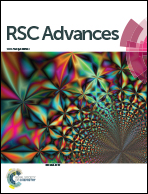Computational study on the mechanism and enantioselectivity of Rh2(S-PTAD)4 catalyzed asymmetric [4+3] cycloaddition between vinylcarbenoids and dienes†
Abstract
In this paper, the mechanism of chiral rhodium-catalyzed [4+3] cycloaddition between a vinylcarbenoid and a diene to form cycloheptadiene has been studied using a two-layer ONIOM methodology consisting of density functional theory and semiempirical PM6. The mechanism involves the formation of vinylcarbenoid via nitrogen extrusion, cyclopropanation to form a divinylcyclopropane through removal of the catalyst, followed by Cope rearrangement of the resulting cis-divinylcyclopropane to form a cycloheptadiene. In this study calculations were carried out on tandem reactions of vinyldiazoacetate and siloxyvinyldiazoacetate with the consideration of geometric isomerism. Through the analysis of thermodynamics and kinetics the Cope rearrangement involving a boat transition state was determined as the rate-controlling step. The computational results indicated that siloxy substituted vinylcarbenoid displays a higher energy barrier and obtains reasonably higher enantioselectivity than for cyclopropanation of unsubstituted vinylcarbenoid, thus it has a critical influence on the favored product of ring extension and the chemical activity. Besides, the geometric isomerism of the substrates and the trapping approach were predicted to have full control over the stereogenic center of the final product rather than the enantioselectivity. Moreover, a desired relationship between the properties of the substrates and reaction energies has been established to understand the reactivity trend by activation strain model (ASM). Finally, an energy span model and AUTOF program were used to create a link between the catalytic cycles and the properties of the substrates.
![Graphical abstract: Computational study on the mechanism and enantioselectivity of Rh2(S-PTAD)4 catalyzed asymmetric [4+3] cycloaddition between vinylcarbenoids and dienes](/en/Image/Get?imageInfo.ImageType=GA&imageInfo.ImageIdentifier.ManuscriptID=C5RA14815D&imageInfo.ImageIdentifier.Year=2015)

 Please wait while we load your content...
Please wait while we load your content...